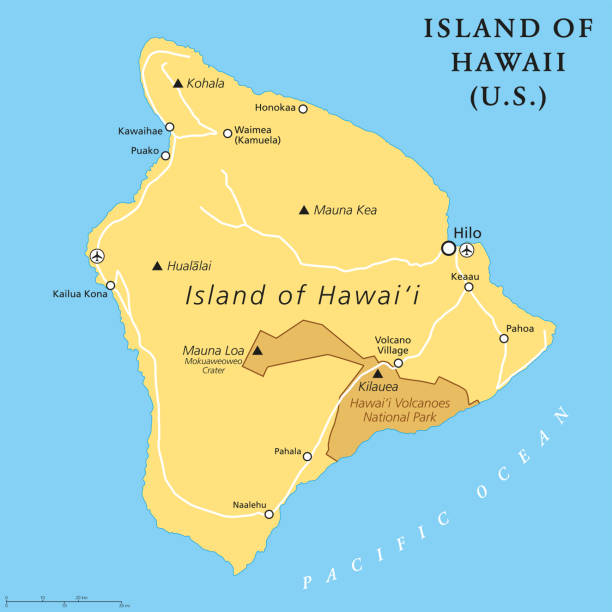Geography
Mauna Loa Volcano
- 05 Nov 2022
- 6 min read
For Prelims: Volcano, Ring of Fire
For Mains: volcano and its distribution
Why in News?
Mauna Loa, the largest active volcano in the world, may erupt in the near future.
Where is Mauna Loa?
- Mauna Loa is one of five volcanoes that together make up the Big Island of Hawaii.
- It is the southernmost island in the Hawaiian archipelago.
- It’s not the tallest (that title goes to Mauna Kea) but it’s the largest and makes up about half of the island’s land mass.
- It sits immediately north of Kilauea volcano, which is currently erupting from its summit crater.
- Kilauea is well-known for a 2018 eruption that destroyed 700 homes and sent rivers of lava spreading across farms and into the ocean.
- Mauna Loa last erupted 38 years ago.
What about the Other Volcanoes?
- Recently Erupted:
- Volcanoes in India:
- Barren Island, Andaman Islands (India's only active volcano)
- Narcondam, Andaman Islands
- Baratang, Andaman Islands
- Deccan Traps, Maharashtra
- Dhinodhar Hills, Gujarat
- Dhosi Hill, Haryana
How are Volcanoes Distributed around the World?
- Volcanoes are distributed all around the world, mostly along the edges of Tectonic Plates, although there are intra-plate volcanoes that form from mantle Hotspots (e.g., Hawaii).
- Some volcanic regions, such as Iceland, happen to occur where there is both a hotspot and a plate boundary.
- World Distribution of Volcano:
- Circum-Pacific Belt:
- The Pacific "Ring of Fire" is a string of volcanoes and sites located on most of the Earth's subduction zones having high seismic activity, around the edges of the Pacific Ocean.
- The Pacific Ring of Fire has a total of 452 volcanoes.
- Most of the active volcanoes are found on its western edge, from the Kamchatka Peninsula in Russia, through the islands of Japan and Southeast Asia, to New Zealand.
- Mid-Continental Belt:
- This volcanic belt extends along the Alpine Mountain system of Europe, north America, through Asia Minor, Caucasia, Iran, Afghanistan and Pakistan to the Himalayan Mountain system, including Tibet, the pamir, Tien-Shan, altai, and the mountains of China, Myammar and eastern Siberia.
- This belt includes the volcanoes of Alps mountains, Mediterranean Sea (Stromboli, Vesuvius, Etna, etc.), volcanoes of Aegean Sea, Mt. Ararat (Turkey), Elburz, Hindukush and Himalayas.
- Mid Atlantic Ridge:
- The Mid-Atlantic Ridge separates the North and South American Plate from the Eurasian and African Plate.
- Magma rises through the cracks and leaks out onto the ocean floor like a long, thin, undersea volcano. As magma meets the water, it cools and solidifies, adding to the edges of the sideways-moving plates.
- This process along the divergent boundary has created the longest topographic feature in the form of Mid oceanic ridges under the Oceans of the world.
- Intra-Plate Volcanoes:
- The 5% of known volcanoes in the world that are not closely related to plate margins are generally regarded as intraplate, or “hot-spot,” volcanoes.
- A hot spot is believed to be related to the rising of a deep-mantle plume, which is caused by very slow convection of highly viscous material in Earth’s mantle.
- It can be represented by a single oceanic volcano or lines of volcanoes such as the Hawaiian-Emperor seamount chains.
- The 5% of known volcanoes in the world that are not closely related to plate margins are generally regarded as intraplate, or “hot-spot,” volcanoes.
- Circum-Pacific Belt:
UPSC Civil Services Examination, Previous Year Question
Prelims
Q. Consider the following statements: (2018)
- The Barren Island volcano is an active volcano located in the Indian territory.
- Barren Island lies about 140 km east of Great Nicobar.
- The last time the Barren Island volcano erupted was in 1991 and it has remained inactive since then.
Which of the statements given above is/are correct?
(a) 1 only
(b) 2 and 3
(c) 3 only
(d) 1 and 3
Ans: (a)
- Barren Island is India’s only active volcano which is located in the Andaman and Nicobar Islands. Hence, statement 1 is correct.
- It is located at about 140 km from Port Blair, southern part of Andaman Island in Andaman Sea. The distance between Barren Island to Great Nicobar is more than the given distance. Hence, statement 2 is not correct.
- First recorded eruption of the volcano dates back to 1787. In the past 100 years, it has erupted at least five times. Then for the next 100 years, it remained silent. It re-erupted massively in 1991.
- Since then, the eruption has been recorded every two-three years; the latest in the series was February 2016. Hence, statement 3 is not correct. Therefore, option (a) is the correct answer.
Mains
Q. Discuss the geophysical characteristics of Circum-Pacific Zone. (2020)
Q. Mention the global occurrence of volcanic eruptions in 2021 and their impact on regional environment. (2021)
Source: IE






